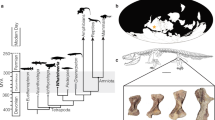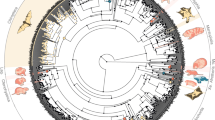Abstract
Bone microstructure is affected by ontogeny, phylogeny, biomechanics and environments. These aspects of life history of an extinct animal, especially its growth patterns, may be assessed as fossil bone generally maintains its histological integrity. Recent studies on the bone histology of fossil vertebrates from India encompass different types of temnospondyls and dicynodonts from different Permian and Triassic horizons. The examined taxa show that they had distinct bone histology and varied growth patterns. The Early Triassic trematosaurids had an overall fast growth, which contrasts with that of the Middle and Late Triassic temnospondyl taxa examined. The dicynodonts on the other hand, were characterized by an overall fast growth with periodic interruptions, variable growth rates dependent on ontogeny and indeterminate growth strategy. A comparative study encompassing several neotherapsid genera including the dicynodonts shows significant evolutionary trends towards determinate growth strategy and reduced developmental plasticity.
Similar content being viewed by others
References
Amprino R 1947 La structure du tissu osseux envisagée comme l’expression de différences dans la vitesse de l’accroissement; Arch. Biol. 58 315–330
Bandyopadhyay S 1988 A kannemeyeriid dicynodont from the Middle Triassic Yerrapalli Formation; Philos. Trans. R. Soc. London B320 185–233
Botha J 2003 Biological aspects of the Permian dicynodont Oudenodon (Therapsida: Dicynodontia) deduced from bone histology and cross-sectional geometry; Palaeontol. Afr. 39 37–44
Botha J and Chinsamy A 2000 Growth patterns deduced from the histology of the cynodonts Diademodon and Cynognathus; J. Vertebr. Palaeontol. 20 705–711
Botha J and Chinsamy A 2004 Growth and life habits of the Triassic cynodont Trirachodon, inferred from bone histology; Acta Paleontol. Polonica 49 619–627
Botha J and Chinsamy A 2005 Growth patterns of Thrinaxodon liorhinus, a non-mammalian cynodont from the Lower Triassic of South Africa; Palaeontology 48 385–394
Buffrénil V de 1980 Mise en evidence de l’incidence des conditions de milieu sur la croissance de Crocodylus siamensis (Schneider, 1801) et valeur des marques de croissance squelettiques pour l’evaluation de l’age individual; Arch. Zool. Exp. Gen. 121 63–76
Chinsamy A 1990 Physiological implications of the bone histology of Syntarsus rhodesiensis (Saurischia: Theropoda); Paleontol. Afr. 27 77–82
Chinsamy A 1995 Ontogenetic changes in the bone histology of the Late Triassic ornithopod Dryosaurus lettowvorbecki; J. Vertebr. Palaeontol. 15 96–104
Chinsamy A 1997 Assessing the biology of the fossil vertebrates through bone histology; Palaeontol. Afr. 33 29–35
Chinsamy A and Dodson P 1995 Inside a dinosaur bone; Am. Sci. 83 174–180
Chinsamy A and Elzanowski A 2001 Evolution in the growth patterns of birds; Nature (London) 412 402–403
Chinsamy A and Hurum J H 2006 Bone microstructure and growth patterns of early mammals; Acta Paleontol. Pol. 51 325–338
Chinsamy A and Rubidge B S 1993 Dicynodont (Therapsida) bone histology: phylogenetic and physiological implications; Palaeontol. Afr. 30 97–102
Chinsamy A, Rich T and Vickers-Rich P 1998 Polar dinosaur bone histology; J. Vertebr. Palaeontol. 18 385–390
Chinsamy-Turan A 2005 The microstructure of dinosaur bone: Deciphering biology with fine-scale techniques (Baltimore: The Johns Hopkins University Press)
Curry K A 1999 Ontogenetic histology of Apatosaurus (Dinosauria: Sauropoda): new insights on growth rates and longevity; J. Vertebr. Palaeontol. 19 654–665
Enlow D H 1963 Principles of bone remodeling (Springfield: Charles C Thomas)
Enlow D H 1969 The bones of reptiles; in Biology of the reptilia (ed) C Gans (New York: Academic Press) pp 45–80
Enlow D H and Brown S O 1957 A comparative histological study of fossil and recent bone tissue 2; Texas J. Sci. 9 186–214
Erickson G M and Tumanova T A 2000 Growth curve of Psittacosaurus mongoliensis Osborn (Ceratopsia: Psittacosauridae) inferred from long bone histology; Zool. J. Linn. Soc. 130 551–556
Esteban M García-Paris M Buckley D and Castanet J 1999 Bone growth and age in Rana saharica, a water frog living in desert environment; Ann. Zool. Fennici 36 53–62
Foote M and Miller A I 2007 Principles of paleontology (New York: W H Freeman)
Francillon-Vieillot H, Buffrénil V de, Castanet J, Gerandie J, Meunier F J, Sire J Y, Zylberberg L L and Ricqlès A de 1990 Microstructure and mineralization of vertebrate skeletal tissues; in Skeletal biomineralization: Patterns, process and evolutionary trends 1 (ed.) J G Carter (New York: Van Nostrand Reinhold) pp 471–530
Goodwin M B and Horner J R 2004 Cranial histology of Pachycephalosaurs (Ornithischia: Marginocephalia) reveals transitory structures inconsistent with head-butting behaviour; Paleobiology 30 253–267
Gross W 1934 Die Typen des mikroskopischen Knochenbaues bei foslen Stegocephalen und Reptilien; Z. Anat. 103 731–764
Horner J R, Ricqlès A and Padian K 1999 Variation in dinosaur skeletochronology indicators: implications for age assessment and physiology; Paleobiology 25 295–304
Horner J R, Padian K and Ricqlès A 2001 Comparatve osteohistology of some embryonic and perinatal archosaurs: developmental and behavioral implications for dinosaurs; Paleobiology 27 39–58
Horner J R, Ricqlès A and Padian K 2000 Long bone histology of the hadrosaurid dinosaur Maiasaura peeblesorum: growth dynamics and physiology based on an ontogenetic series of skeletal elements; J. Vertebr. Palaeontol. 20 115–129
Hutton J M 1986 Age determination of living Nile crocodiles from the cortical stratification of bone; Copeia 1986 332–341
Huxley T H 1865 On vertebrate fossils from the Panchet rocks near Raniganj, Bengal; Paleontol. Indica 4 1–24
Klevezal G A 1996 Recording Structures Of Mammals (Brookfield: A A Balkema Publishers)
Laurin M, Girondot M and Loth M M 2004 The evolution of long bone microstructure and lifestyle in lissamphibians; Paleobiology 30 589–613
Margerie E de, Cubo J and Castanet J 2002 Bone typology and growth rate: testing and quantifying ‘Amprino’s rule’ in the mallard (Anas platyrhynchos); C. R. Acad. Sci., Série Biol. 325 221–230
Mukherjee D Ray S and Sengupta D P 2008 Differing growth patterns and inferred life habits of the Triassic temnospondyls from India; International conference on geology: Indian scenario and global context, Abstract volume 75
Mukherjee D Ray S and Sengupta D Preliminary observations on the bone microstructure, growth patterns, and life habits of some Triassic temnospondyls from India; J. Vertebr. Palaeontol. (in press)
Mukherjee R N and Sengupta D P 1998 New capitosaurid amphibians from the middle Triassic Denwa Formation of Satpura Gondwanas, Central India; Alcheringa 22 317–327
Padian K, Horner J R and Ricqlès A de 2004 Growth in small dinosaurs and pterosaurs: the evolution of archosaurian growth strategies; J. Vertebr. Palaeontol. 24 555–571
Ray S 2000 Endothiodont dicynodonts from the Late Permian Kundaram Formation, India; Palaeontology 43 375–404
Ray S and Chinsamy A 2004 Diictodon feliceps (Therapsida, Dicynodontia): bone histology, growth and biomechanics; J. Vertebr. Palaeontol. 24 180–194
Ray S, Botha J and Chinsamy A 2004 Bone histology and growth patterns of some non-mammalian therapsids; J. Vertebr. Palaeontol. 24 634–648
Ray S, Chinsamy A and Bandyopadhyay S 2005 Lystrosaurus murrayi (Therapsida, Dicyndontia): Bone histology, growth and lifestyle adaptations; Palaeontology 48 1169–1185
Ray S, Bandyopadhyay S and Bhawal D 2009 Growth patterns as deduced from bone microstructure of some selected neotherapsids with special emphasis on dicynodonts: phylogenetic implications; Paleoworld 18 53–66
Ray S, Bandyopadhyay S and Appana R Bone histology of a kannemeyeriid dicynodont Wadiasaurus: paleobiological implications; in New aspects of Mesozoic diversity (ed.) S Bandyopadhyay (Lecture notes in Earth Sciences, Springer-Verlag) (in press)
Reid R E H 1990 Zonal ‘growth rings’ in dinosaurs; Mod. Geol. 15 19–48
Ricqlès A de 1972 Recherches paléohistologiques sur les os longs des Tétrapodes. III, Titanosuchiens, Dinocéphales et Dicynodontes; Ann. Paléontol. (Vertébr.) 58 17–60
Ricqlès A de 1976 On bone histology of fossil and living reptiles with comments on its functional and evolutionary significance; in Morphology and Biology of Reptiles Linnean Society Symposium Series 3 (eds) A d’A Bellairs and C B Cox (London: Academic Press) pp 123–149
Ricqlès A de, Meunier F J, Castanet J and Francilon-Vieillot H 1991 Comparative microstructure of bone; in Bone 3: Bone matrix and bone specific products (ed) B K Hall (Boca Raton: CRC Press Inc.) pp 1–77
Sander P M 2000 Long bone histology of the Tendaguru sauropods: an implication for growth and biology; Paleobiology 26 466–488
Sengupta D P 1995 Chigutisaurid temnospondyls from the Late Triassic of India and a review of the family Chigutisauridae; Palaeontology 38 313–339
Smith-Gill S J 1983 Developmental plasticity: developmental conversion versus phenotypic modulation; Am. Zool. 23 47–55
Steyer J S, Laurin M, Castanet J and Ricqlès A de 2004 First histological and skeletochronological data on temnospondyl growth: paleogeological and paleoclimatological implications; Paleogeogr. Paleoclimat. Paleoecol. 206 193–201
Ten Cate A R 1994 Oral histology: development, structure and function; 4th edition (Mosby-Year Book)
Tripathi C 1969 Fossil labyrinthodonts from the Panchet Series of the Indian Gondwanas; Palaeontol. Indica 38 1–45
Tripathi C and Satsangi P P 1963 Lystrosaurus fauna of the Panchet series of the Raniganj coalfield; Palaeontol. Indica 37 1–55
Author information
Authors and Affiliations
Corresponding author
Rights and permissions
About this article
Cite this article
Ray, S., Mukherjee, D. & Bandyopadhyay, S. Growth patterns of fossil vertebrates as deduced from bone microstructure: case studies from India. J Biosci 34, 661–672 (2009). https://doi.org/10.1007/s12038-009-0055-x
Published:
Issue Date:
DOI: https://doi.org/10.1007/s12038-009-0055-x




